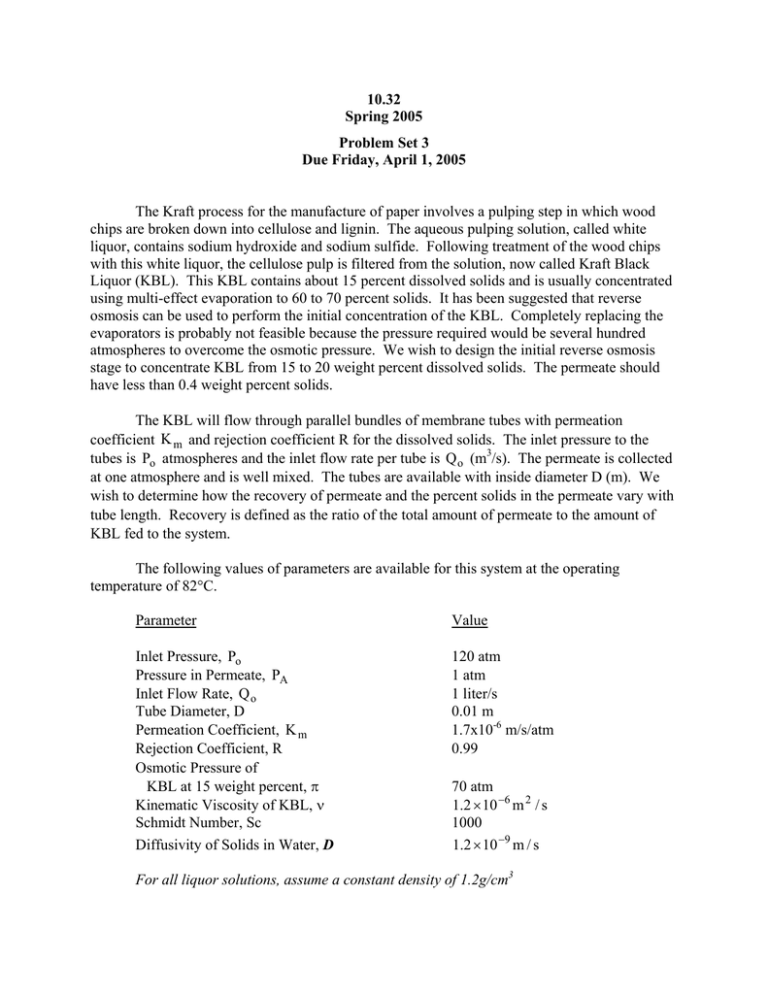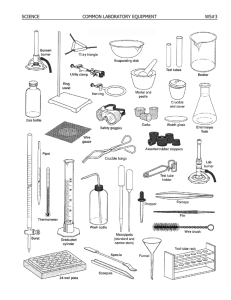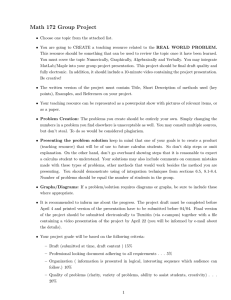10.32 Spring 2005 Problem Set 3 Due Friday, April 1, 2005
advertisement

10.32 Spring 2005 Problem Set 3 Due Friday, April 1, 2005 The Kraft process for the manufacture of paper involves a pulping step in which wood chips are broken down into cellulose and lignin. The aqueous pulping solution, called white liquor, contains sodium hydroxide and sodium sulfide. Following treatment of the wood chips with this white liquor, the cellulose pulp is filtered from the solution, now called Kraft Black Liquor (KBL). This KBL contains about 15 percent dissolved solids and is usually concentrated using multi-effect evaporation to 60 to 70 percent solids. It has been suggested that reverse osmosis can be used to perform the initial concentration of the KBL. Completely replacing the evaporators is probably not feasible because the pressure required would be several hundred atmospheres to overcome the osmotic pressure. We wish to design the initial reverse osmosis stage to concentrate KBL from 15 to 20 weight percent dissolved solids. The permeate should have less than 0.4 weight percent solids. The KBL will flow through parallel bundles of membrane tubes with permeation coefficient K m and rejection coefficient R for the dissolved solids. The inlet pressure to the tubes is Po atmospheres and the inlet flow rate per tube is Q o (m3/s). The permeate is collected at one atmosphere and is well mixed. The tubes are available with inside diameter D (m). We wish to determine how the recovery of permeate and the percent solids in the permeate vary with tube length. Recovery is defined as the ratio of the total amount of permeate to the amount of KBL fed to the system. The following values of parameters are available for this system at the operating temperature of 82°C. Parameter Value Inlet Pressure, Po Pressure in Permeate, PA Inlet Flow Rate, Q o Tube Diameter, D Permeation Coefficient, K m Rejection Coefficient, R Osmotic Pressure of KBL at 15 weight percent, π Kinematic Viscosity of KBL, ν Schmidt Number, Sc Diffusivity of Solids in Water, D 120 atm 1 atm 1 liter/s 0.01 m 1.7x10-6 m/s/atm 0.99 70 atm 1.2 × 10 −6 m 2 / s 1000 1.2 × 10 −9 m / s For all liquor solutions, assume a constant density of 1.2g/cm3 a) Qualitatively sketch how you think following parameters will vary with tube length. 1. 2. 3. 4. 5. Solids concentration in retentate Flow rate in the tube Flux through tube walls Solids concentration in permeate (before mixing) Recovery Briefly, justify the shape of each curve. b) There are two major costs associated with a reverse osmosis system, capital cost of the membrane tubes and electric power to increase the pressure of the inlet liquid. Would you expect there to be an optimum tube length? Justify your answer. c) We wish to derive a set of equations and devise a calculation scheme to determine the performance of a reverse osmosis tube as a function of its length. The recovery of permeate and the concentration of solids in the permeate define the performance of the process. d) Use your equations, calculation scheme, and the parameters given in the problem statement to find the recovery and concentration of solids in the permeate as a function of the tube length up to 15 meters.




